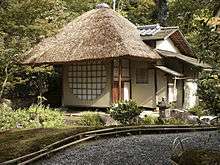Kōdai-ji

Kōdai-ji (高台寺 Kōdai-ji), formally identified as Jubuzan Kōdai-ji (鷲峰山高台寺 Jubuzan Kōdai-ji), is a temple of the Rinzai school of Zen Buddhism in Higashiyama-ku, Kyoto, Japan—the largest subtemple of the Kennin-ji branch. It was established in 1606 by Nene (often known by the title Kita no Mandokoro, and who had taken the name Kōdai-in), the widow of Toyotomi Hideyoshi, to pray for her late husband. The principal image is a statue of Shaka.

The temple possesses a number of objects designated as Important Cultural Assets. Among these are the Main Gate and the Spirit Hall, noted for its use of maki-e. The temple is nicknamed the maki-e temple." It also holds paintings, including one of Hideyoshi, as well as textiles, and a bronze bell with an inscription dating it to 1606.
The gardens of Kōdai-ji are a nationally designated Historic Site and Place of Scenic Beauty.[1]
See also
- For an explanation of terms concerning Japanese Buddhism, Japanese Buddhist art, and Japanese Buddhist temple architecture, see the Glossary of Japanese Buddhism.
References
- ↑ "高台寺庭園". Agency for Cultural Affairs. Retrieved 10 February 2012.
External links
- 高台寺 Official site (in Japanese and Chinese)
35°00′03″N 135°46′52″E / 35.000761°N 135.781114°ECoordinates: 35°00′03″N 135°46′52″E / 35.000761°N 135.781114°E